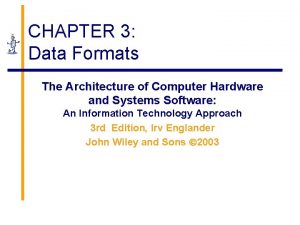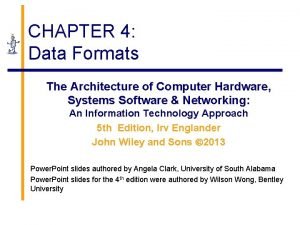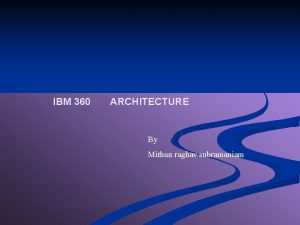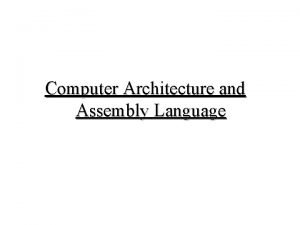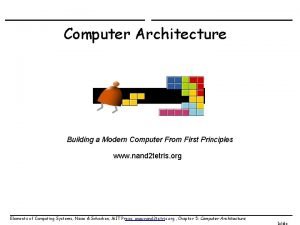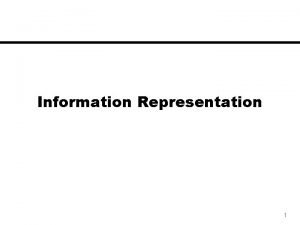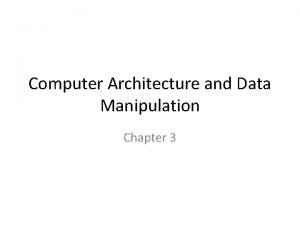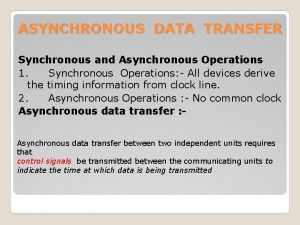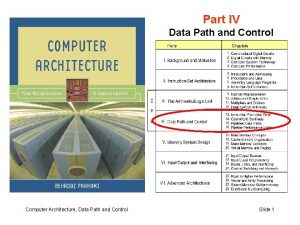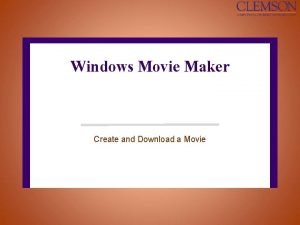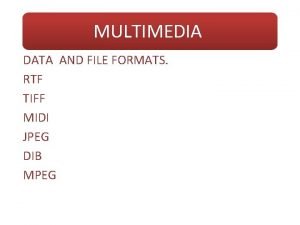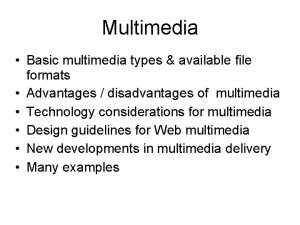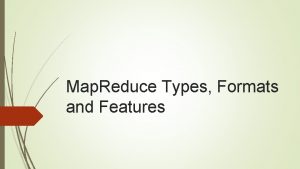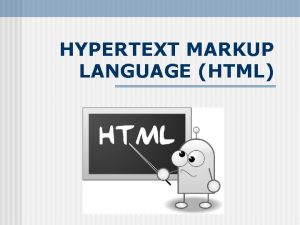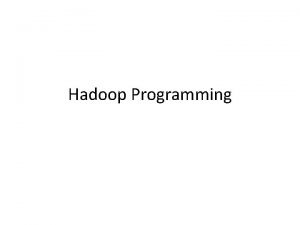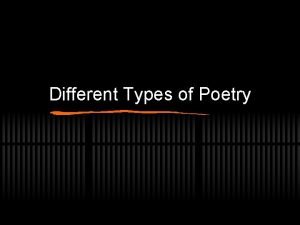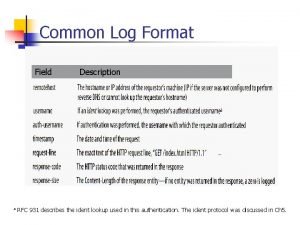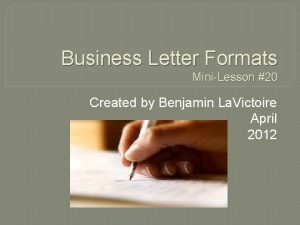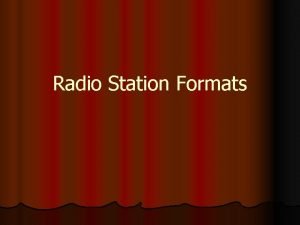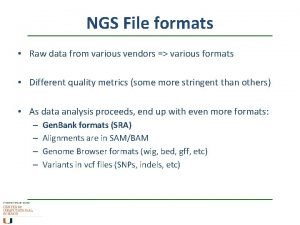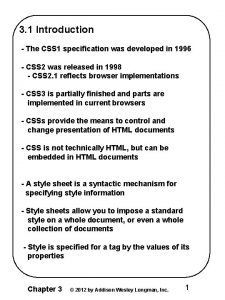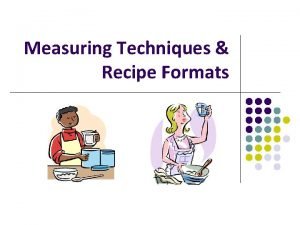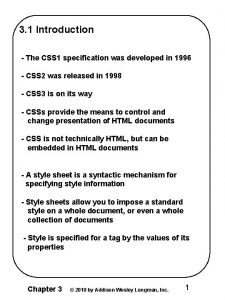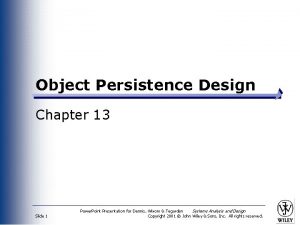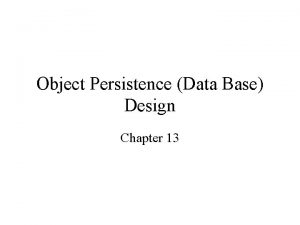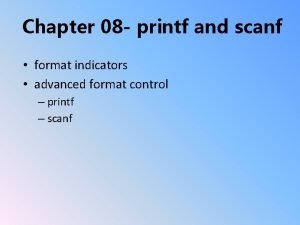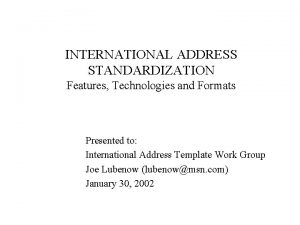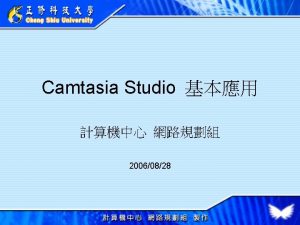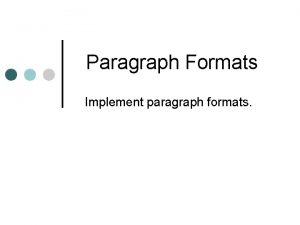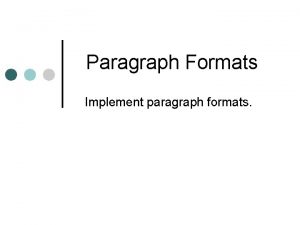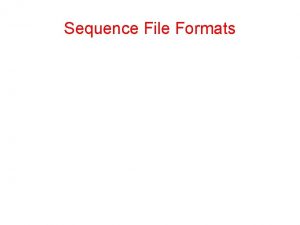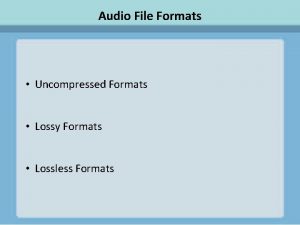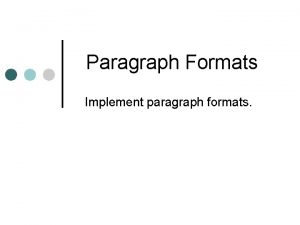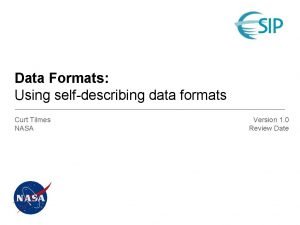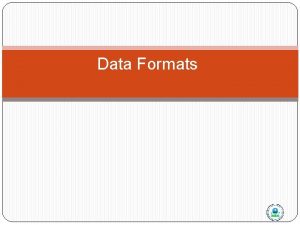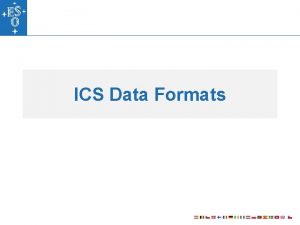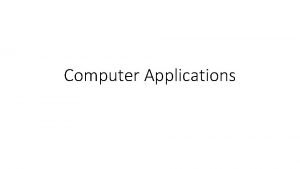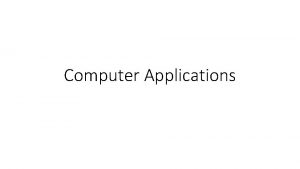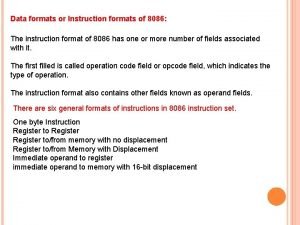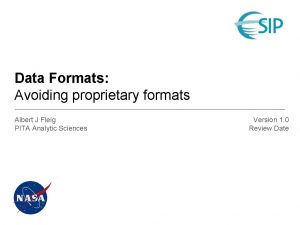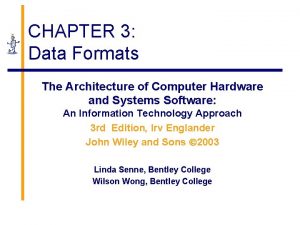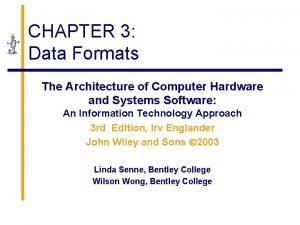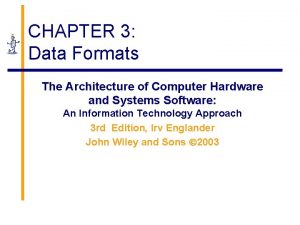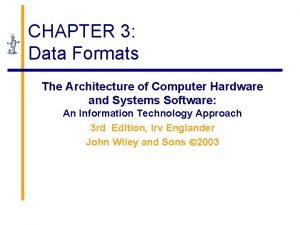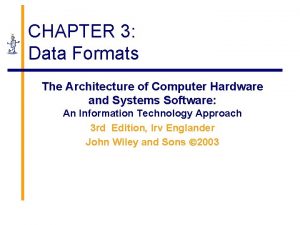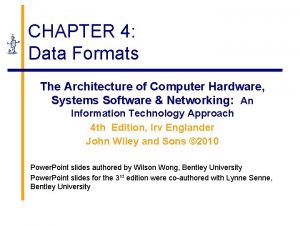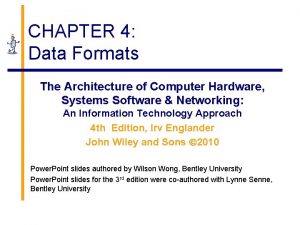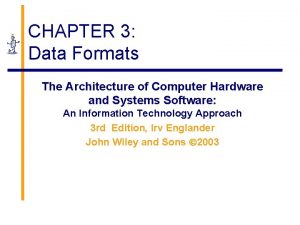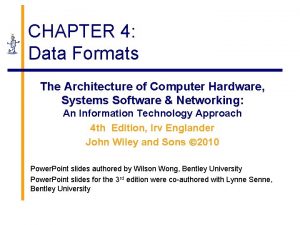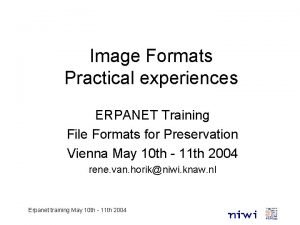CHAPTER 4 Data Formats The Architecture of Computer


















![Bitmap Images § Each individual pixel, for pi[x]cture element, in a graphic is stored Bitmap Images § Each individual pixel, for pi[x]cture element, in a graphic is stored](https://slidetodoc.com/presentation_image_h/244eed15becc5e6f906c9f6157491d2a/image-19.jpg)






















- Slides: 41

CHAPTER 4: Data Formats The Architecture of Computer Hardware, Systems Software & Networking: An Information Technology Approach 5 th Edition, Irv Englander John Wiley and Sons 2013 Power. Point slides authored by Angela Clark, University of South Alabama Power. Point slides for the 4 th edition were authored by Wilson Wong, Bentley University

Data Formats § Computers and computer-based devices § Process and store all forms of data in binary format § Human communication § Includes language, images and sounds § Data formats § Specifications for converting data into computerusable form § Define the different ways human data may be represented, stored and processed by a computer Copyright 2013 John Wiley & Sons, Inc. 4 -2

Sources of Data § Binary input § Begins as discrete input § Example: keyboard input such as A 1+2=3 math § Keyboard generates a binary number code for each key § Analog § Continuous data such as sound or images § Requires hardware to convert data into binary numbers Computer A 1+2=3 math Input device Copyright 2013 John Wiley & Sons, Inc. 110100010101… 4 -3

Common Data Representations Type of Data Standard(s) Alphanumeric Unicode, ASCII, EDCDIC Image (bitmapped) §GIF (graphical image format) §TIFF (tagged image file format) §PNG (portable network graphics) Image (object) Post. Script, JPEG, SWF (Adobe Flash), SVG Outline graphics and fonts Post. Script, True. Type Sound WAV, AVI, MP 3, MIDI, WMA Page description PDF (Portable Document Format), HTML, XML Video Quicktime, MPEG-2, MPEG-4, WMV Copyright 2013 John Wiley & Sons, Inc. 4 -4

Internal Data Representation § Reflects the § Complexity of input source § Type of processing required § Trade-offs § Accuracy and resolution p Simple photo vs. figure in an art book § Compactness (storage and transmission) p p p More data required for improved accuracy and resolution Compression represents data in a more compact form Metadata: data that describes or interprets the meaning of data Copyright 2013 John Wiley & Sons, Inc. 4 -5

Internal Data Representation § Ease of manipulation: p Processing simple audio vs. high-fidelity sound § Standardization Proprietary formats for storing and processing data (Word. Perfect vs. Word) p De facto standards: proprietary standards based on general user acceptance (Post. Script) p Copyright 2013 John Wiley & Sons, Inc. 4 -6

Data Types: Numeric § Used for mathematical manipulation § Add, subtract, multiply, divide § Types § Integer (whole number) § Real (contains a decimal point) § Covered in Chapter 5 Copyright 2013 John Wiley & Sons, Inc. 4 -7

Data Types: Alphanumeric § Alphanumeric: § § Characters: b T Number digits: 7 9 Punctuation marks: ! ; Special-purpose characters: $ & § Numeric characters vs. numbers § Both entered as ordinary characters § Computer converts into numbers for calculation p Examples: Variables declared as numbers by the programmer (Salary$ in BASIC) § Treated as characters if processed as text p Examples: Phone numbers, ZIP codes Copyright 2013 John Wiley & Sons, Inc. 4 -8

Alphanumeric Codes § Arbitrary choice of bits to represent characters § Consistency: input and output device must recognize same code § Value of binary number representing character corresponds to placement in the alphabet p Facilitates sorting and searching Copyright 2013 John Wiley & Sons, Inc. 4 -9

Representing Characters § ASCII - most widely used coding scheme § EBCDIC: IBM mainframe (legacy) § Unicode: developed for worldwide use Copyright 2013 John Wiley & Sons, Inc. 4 -10

ASCII § Developed by ANSI (American National Standards Institute) § Represents § Latin alphabet, Arabic numerals, standard punctuation characters § Plus small set of accents and other European special characters § ASCII § 7 -bit code: 128 characters Copyright 2013 John Wiley & Sons, Inc. 4 -11

ASCII Reference Table MSD LSD 0 1 2 3 4 5 0 NUL DLE SP 0 @ P 1 SOH DC 1 ! 1 A Q a W 2 STX DC 2 “ 2 B R b r 3 ETX DC 3 # 3 C S c s 4 EOT DC 4 $ 4 D T d t 5 ENQ NAK % 5 E U e u 6 ACJ SYN & 6 F V f v 7 BEL ETB ‘ 7 G W g w 8 BS CAN ( 8 H X h x 9 HT EM ) 9 I Y i y A LF SUB * : J Z j z B VT ESC + ; K [ k { C FF FS , < L l | D CR GS - = M ] m } E SO RS . > N ^ n ~ F SI US / ? O _ o DEL Copyright 2013 John Wiley & Sons, Inc. 6 7 p 7416 111 0100 4 -12

EBCDIC § Extended Binary Coded Decimal Interchange Code developed by IBM § Restricted mainly to IBM or IBM compatible mainframes § Conversion software to/from ASCII available § Common in archival data § Character codes differ from ASCII EBCDIC Space 2016 4016 A 4116 C 116 b 6216 8216 Copyright 2013 John Wiley & Sons, Inc. 4 -13

Unicode § Most common 16 -bit form represents 65, 536 characters § ASCII Latin-I subset of Unicode § Values 0 to 255 in Unicode table § Multilingual: defines codes for § Nearly every character-based alphabet § Large set of ideographs for Chinese, Japanese and Korean languages § Composite characters for vowels and syllabic clusters required by some languages § Allows software modifications for locallanguages Copyright 2013 John Wiley & Sons, Inc. 4 -14

Collating Sequence § Alphabetic sorting if software handles mixed upper- and lowercase codes § In ASCII, numbers collate first; in EBCDIC, last § ASCII collating sequence for string of characters Letters Numeric Characters Adam A d a m Adamian A d a m i a n Adams A d a m s Copyright 2013 John Wiley & Sons, Inc. 1 011 0001 12 011 0001 011 0010 2 011 0010 4 -15

2 Classes of Codes § Printing characters § Produced on the screen or printer § Control characters § Control position of output on screen or printer p VT: vertical tab p LF: Line feed § Cause action to occur p BEL: bell rings p DEL: delete current character § Communicate status between computer and I/O device ESC: provides extensions by changing the meaning of a specified number of contiguous following characters p Copyright 2013 John Wiley & Sons, Inc. 4 -16

Visual Data § Videos, photographs, biometric images, figures, icons, drawings, charts and graphs § Two approaches: § Bitmap or raster images of photos and paintings with continuous variation § Object or vector images composed of graphical objects like lines and curves defined geometrically § Differences include: § § Quality of the image Storage space required Time to transmit Ease of modification Copyright 2013 John Wiley & Sons, Inc. 4 -17

Bitmap Images § Used for realistic images with continuous variations in shading, color, shape and texture § Preferred when image contains large amount of detail and processing requirements are fairly simple § Input devices: § Scanners § Digital cameras and video capture devices § Graphical input devices like mice and pens § Managed by photo editing software or paint software Copyright 2013 John Wiley & Sons, Inc. 4 -18
![Bitmap Images Each individual pixel for pixcture element in a graphic is stored Bitmap Images § Each individual pixel, for pi[x]cture element, in a graphic is stored](https://slidetodoc.com/presentation_image_h/244eed15becc5e6f906c9f6157491d2a/image-19.jpg)
Bitmap Images § Each individual pixel, for pi[x]cture element, in a graphic is stored as a binary number § Pixel: A small area with an associated coordinate location § Example: each point below represented by a 4 -bit code corresponding to 1 of 16 shades of gray Copyright 2013 John Wiley & Sons, Inc. 4 -19

Bitmap Display § Monochrome: black or white § 1 bit per pixel § Gray scale: black, white or 254 shades of gray § 1 byte per pixel § Color graphics: 16 colors, 256 colors, or 24 -bit true color (16. 7 million colors) § 4, 8, and 24 bits respectively Copyright 2013 John Wiley & Sons, Inc. 4 -20

Storing Bitmap Images § Frequently large files § Example: 768 rows of 1024 pixels with 1 byte for each of 3 colors ~2. 4 MB file § File size affected by § Resolution (the number of pixels per inch) p Amount of detail affecting clarity and sharpness of an image § Levels: number of bits for displaying shades of gray or multiple colors p Palette: color translation table that uses a code for each pixel rather than actual color value § Data compression Copyright 2013 John Wiley & Sons, Inc. 4 -21

GIF (Graphics Interchange Format) § First developed by Compu. Serve in 1987 § GIF 89 a enabled animated images § Allows images to be displayed sequentially at fixed time sequences § Color limitation: 256 § Image compressed by LZW (Lempel-Zif. Welch) algorithm § Preferred for line drawings, clip art and pictures with large blocks of solid color § Lossless compression Copyright 2013 John Wiley & Sons, Inc. 4 -22

GIF (Graphics Interchange Format) Copyright 2013 John Wiley & Sons, Inc. 4 -23

PNG (Portable Network Graphics) § Losslesly-compressed alternative to GIF § Can store up to 48 bits of color per pixel § Can also store transparency percentage value and color correction factor for monitor or printer § More efficient compression algorithm than GIF Copyright 2013 John Wiley & Sons, Inc. 4 -24

JPEG (Joint Photographers Expert Group) § Allows more than 16 million colors § Suitable for highly detailed photographs and paintings § Employs lossy compression algorithm that § Discards data to decreases file size and transmission speed § May reduce image resolution, tends to distort sharp lines Copyright 2013 John Wiley & Sons, Inc. 4 -25

Object Images § Created by drawing software or output from spreadsheet data graphs § Composed of lines and shapes in various colors § Computer translates geometric formulas to create the graphic § Storage space depends on image complexity § Number of instructions to create lines, shapes, fill patterns § Movies such as Shrek and Toy Story use object images Copyright 2013 John Wiley & Sons, Inc. 4 -26

Object Images § Based on mathematical formulas § Easy to move, scale, and rotate without losing shape and identity as bitmap images may § Require less storage space than bitmap images § Cannot represent photos or paintings § Cannot be displayed or printed directly § Must be converted to bitmap since output devices except plotters are bitmap Copyright 2013 John Wiley & Sons, Inc. 4 -27

Post. Script § Page description language: list of procedures and statements that describe each of the objects to be printed on a page § Stored in ASCII or Unicode text file § Interpreter program in computer or output device reads Post. Script to generate image § Scalable font support § Font outline objects specified like other objects Copyright 2013 John Wiley & Sons, Inc. 4 -28

Bitmap vs. Object Images Bitmap (Raster) Object (Vector) Pixel map Geometrically defined shapes Photographic quality Complex drawings Paint software Drawing software Larger storage requirements Higher computational requirements Enlarging images produces jagged Objects scale smoothly edges Resolution of output limited by resolution of image Copyright 2013 John Wiley & Sons, Inc. Resolution of output limited by output device 4 -29

Video Images § Require massive amount of data § Video camera producing full screen 1024 x 768 pixel true color image at 30 frames/sec 70. 8 MB of data/sec § 1 -minute film clip 4. 25 GB storage § Options for reducing file size: decrease size of image, limit number of colors, or reduce frame rate § Video format determined by a codec, encoder/decoder Copyright 2013 John Wiley & Sons, Inc. 4 -30

Video Images § Best known codec standards: MPEG-2, MPEG -4, and H. 264 § Data may be compressed to 10 -60 MB or less of data per minute § Container serves as a superstructure to encode, decode, hold and stream the video § Examples: Quicktime from Apple, Web. M from Google, and Flash Video from Adobe § Streaming video: video displayed in real time as it is downloaded from the Web server Copyright 2013 John Wiley & Sons, Inc. 4 -31

Audio Data § Transmission and processing requirements less demanding than those for video § Analog Waveform: digital representation of sound § Analog sound converted to digital values by A -to-D converter § MIDI (Musical Instrument Digital Interface): instructions to recreate or synthesize sounds Copyright 2013 John Wiley & Sons, Inc. 4 -32

Waveform Audio Sampling rate normally 50 KHz Copyright 2013 John Wiley & Sons, Inc. 4 -33

Sampling Rate § Number of times per second that sound is measured during the recording process. § 1000 samples per second = 1 KHz (kilohertz) § Example: Audio CD sampling rate = 44. 1 KHz § Height of each sample saved as: § 8 -bit number for radio-quality recordings § 16 -bit number for high-fidelity recordings § 2 x 16 -bits for stereo Copyright 2013 John Wiley & Sons, Inc. 4 -34

Audio Formats § MP 3 – predominant digital audio data format § Derivative of MPEG-2 (ISO Moving Picture Experts Group) § Uses psychoacoustic lossy compression techniques to reduce storage requirements § WAV § Developed by Microsoft as part of its multimedia specification § General-purpose format for storing and reproducing small snippets of sound § Non-compressed 8 - or 16 -bit sound samples Copyright 2013 John Wiley & Sons, Inc. 4 -35

Audio Data Formats WAV file Copyright 2013 John Wiley & Sons, Inc. 4 -36

Data Compression § Compression: recoding data so that it requires fewer bytes of storage space. § Compression ratio: the amount file size is reduced § Lossless: inverse algorithm restores data to exact original form § Examples: GIF, PCX, TIFF, ZIP § Lossy: trades off data degradation for file size and download speed § Much higher compression ratios, often 10 to 1 § Example: JPEG, MP 3 § Common in multimedia § H. 264: uses both forms for ratios of 1000: 1 Copyright 2013 John Wiley & Sons, Inc. 4 -37

Page Description Languages § Describe layout of objects on a displayed or printed page § Objects may include text, object images, bitmap images, multimedia objects, and other data formats § Examples § HTML, XML § PDF § Postscript Copyright 2013 John Wiley & Sons, Inc. 4 -38

Internal Computer Data Format § All data stored as binary numbers § Interpreted based on § Operations computer can perform § Data types supported by programming language used to create application Copyright 2013 John Wiley & Sons, Inc. 4 -39

5 Simple Data Types § Boolean: 2 -valued variables or constants with values of true or false § Char: Variable or constant that holds alphanumeric character § Enumerated § User-defined data types with possible values listed in definition p Type Day. Of. Week = Mon, Tues, Wed, Thurs, Fri, Sat, Sun § Integer: positive or negative whole numbers § Real § Numbers with a decimal point § Numbers whose magnitude, large or small, exceeds computer’s capability to store as an integer Copyright 2013 John Wiley & Sons, Inc. 4 -40

Copyright 2013 John Wiley & Sons All rights reserved. Reproduction or translation of this work beyond that permitted in section 117 of the 1976 United States Copyright Act without express permission of the copyright owner is unlawful. Request for further information should be addressed to the Permissions Department, John Wiley & Sons, Inc. The purchaser may make back-up copies for his/her own use only and not for distribution or resale. The Publisher assumes no responsibility for errors, omissions, or damages caused by the use of these programs or from the use of the information contained herein. ” Copyright 2013 John Wiley & Sons, Inc. 4 -41
 Computer data format
Computer data format Data formats in computer architecture
Data formats in computer architecture Compare stl and slc file format
Compare stl and slc file format Mithun subramaniam
Mithun subramaniam Three bus architecture
Three bus architecture Diff between computer architecture and organization
Diff between computer architecture and organization Complete computer description in computer organization
Complete computer description in computer organization Bytexl
Bytexl Data hazards in computer architecture
Data hazards in computer architecture Program counter nand2tetris
Program counter nand2tetris Computer memory representation
Computer memory representation Data manipulation in computer architecture
Data manipulation in computer architecture Synchronous vs asynchronous data transfer
Synchronous vs asynchronous data transfer Data path in computer architecture
Data path in computer architecture Windows movie maker 2012 download
Windows movie maker 2012 download File formats in multimedia
File formats in multimedia File formats in multimedia
File formats in multimedia Map reduce types
Map reduce types File formats in multimedia
File formats in multimedia Input formats in hadoop
Input formats in hadoop Quatrain poem examples
Quatrain poem examples Squid log parser
Squid log parser Business writing formats
Business writing formats How do the various letter formats differ from each other?
How do the various letter formats differ from each other? Radio station music formats
Radio station music formats Comparing business letters and memos worksheet answers
Comparing business letters and memos worksheet answers Ngs file formats
Ngs file formats Style specification formats
Style specification formats Narrative form recipe
Narrative form recipe Hadoop file formats
Hadoop file formats Style specification formats
Style specification formats Object persistence formats
Object persistence formats Object persistence formats
Object persistence formats Scanf formats
Scanf formats International address formats
International address formats Power point codec
Power point codec Small group stages formats and culture
Small group stages formats and culture 4 tier architecture of data warehouse
4 tier architecture of data warehouse Hình ảnh bộ gõ cơ thể búng tay
Hình ảnh bộ gõ cơ thể búng tay Ng-html
Ng-html Bổ thể
Bổ thể Tỉ lệ cơ thể trẻ em
Tỉ lệ cơ thể trẻ em
